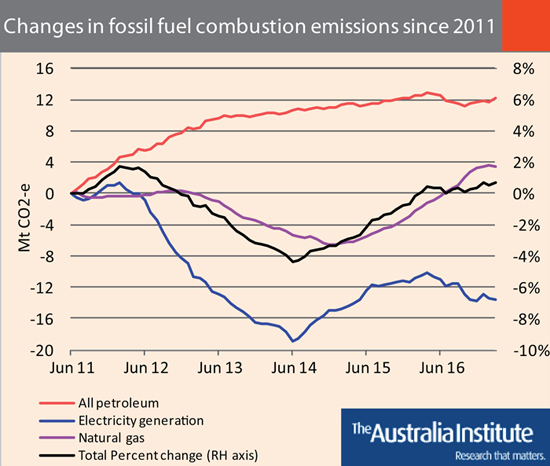Our governments have been cooking the carbon accounting books. It’s past time they stopped.

From Hugh Saddler’s National Energy Emissions Audit, June 2017 (The Australia Institute).
There are many measures of our performance in reducing carbon emissions, but only one that counts. As Bill Clinton might have said, it’s the atmosphere, stupid!
In the mid-1950s Charles David Keeling’s first analysis of the concentration of carbon dioxide in the atmosphere put it at 310 parts per million (ppm). A few years later, after factoring in daily and seasonal fluctuations, Keeling discovered the rising trend we’re familiar with today.
In 2013 the level at Mauna Loa Observatory, Hawaii, rose above 400 ppm for the first time. It is now much higher everywhere – even at the South Pole – and for the past two years it’s been rising globally at an unprecedented rate.
Australia is among many jurisdictions that have claimed their national emissions are under control, including multiple statements to that effect by environment minister Josh Frydenberg and his predecessor, Greg Hunt. We will “easily” meet our targets, they say.
What’s happening here? We know that China and India are big emitters, but with global emissions rising so quickly could Australia be as squeaky-clean as it claims?
The letter of the law says Frydenberg and Hunt are right. National data collected under internationally-agreed formulas clearly show us under our 2012 Kyoto target and likely to be the same for our 2020 target. But science and common sense say otherwise.
Science warns that the main cause of warming is direct emissions from fossil fuels, and Australia’s fossil-fuel emissions rose by 28 per cent between 1990 and 2012. That the government is able to imply otherwise is due mainly to a deal known as the “Australia clause” of the Kyoto Protocol
Secured by the Howard government when it threatened to pull out of climate talks in 1997, this clause and the overarching Kyoto decision to cover land use and forestry allow federal and state governments to selectively use such data to “offset” (or conceal) increases in fossil-fuel emissions.
Tasmanian emissions, for instance, are made to look spectacularly good by including take-up of carbon by today’s regrowing forests, yet our fossil-fuel emissions have not moved for years. Greg Hunt called this sort of accounting “gold standard”. I call it cooking the books.
Real gold-standard emissions accounting is the aim of Hugh Saddler, of the ANU’s Centre for Climate Economics and Policy. The story told in his latest quarterly National Energy Emissions Audit, published by the Australia Institute, is in stark contrast to the official one.
There’s a lot to learn from Saddler’s graphs of energy emissions since 2010. Emissions from coal and gas generation dropped markedly during the years of a carbon price (2012 to 2014), but rose sharply from July 2014 when the price was abolished. We hear nothing of that from government.
Saddler’s latest report shows Australian emissions rising because of natural gas burned in the production process for liquefied natural gas, despite slightly lower emissions from electricity generation due to a fall in demand and more grid-connected wind and solar farms.
Latest official figures, for 2014-15, show a small annual decrease in total Australian emissions but a rise by 1.4 per cent when land-use data is removed. As Saddler points out, the official figure showing a big emissions reduction since 2005 was entirely due to land-use data.
There are similar lessons for the Hodgman government in some detailed analysis of Tasmanian emissions by Todd Houstein, an engineer by training who now manages the non-government organisation Sustainable Living Tasmania.
Extrapolating from the internationally-recognised global carbon budget (the permissible amount of fossil-fuel emissions for a safe climate), Houstein calculates that on a per-capita, business-as-usual basis Tasmania’s share will be gone in less than 10 years.
That must not be the end of the story. With community and business focused on a clean energy future, guided by a government with vision, Australia can make huge strides in a very short space of time. But first, people have to be properly informed.
We will only make real progress on emissions when governments find the courage and resolve to come clean about the data. Until then, we’re living a lie.
